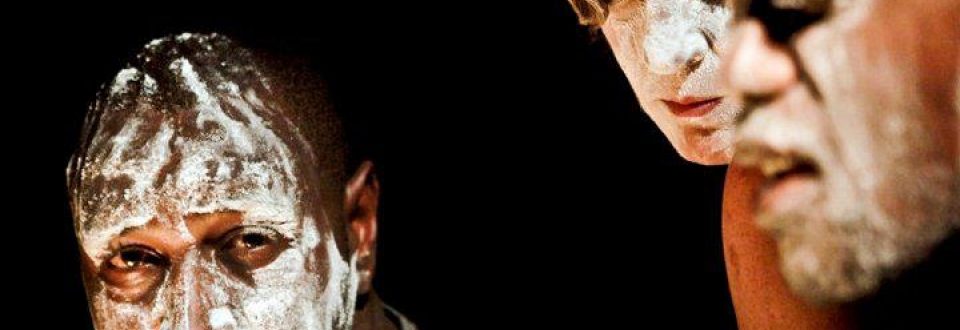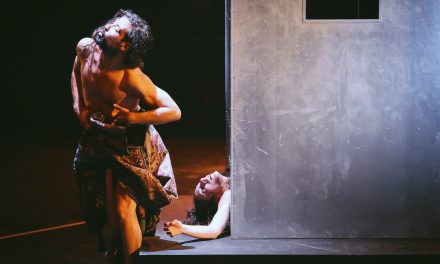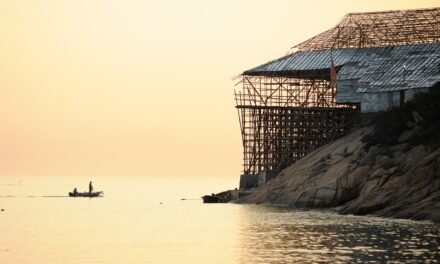IETM will host its forthcoming Plenary meeting in Porto, Portugal, with a specific focus on “Other centres”: new and alternative perspectives and paths in the processes of producing and disseminating the arts. This series reveals how the Portuguese arts sector relates to the topic.
Marielle Franco, city councilor of Rio de Janeiro, Brazil, was shot dead on March 14. News reports said that thirteen bullets, which can be traced back to federal police (and were allegedly stolen from a post office), were fired at the car: four hit Marielle Franco’s body; others killed Anderson Gomes, the driver, and injured Fernanda Chaves, Franco’s assistant.
On March 16 and 19, gatherings took place in Lisbon, Portugal, paying tribute to Franco and her efforts to denounce the violence of the military police in the favelas, as well as to her work to improve their conditions—and the awareness of those conditions—for the lives of many.
One of the posters, held by a teenager wearing a yellow vest from Amnesty, read: “It is not happening here but it is happening now.” Portuguese politicians are not being fired at in the streets. In that sense, it is not happening here. But, as Jorge Luis Borges wrote in In Memoriam, J.F.K., “This bullet is an old one.” “In the dawn of time” this bullet was “a stone” and, in the future, it will “be many things that we cannot imagine today.” Bullets travel through time and space. They are present at all times, and they are present in all places. It is happening now and it is happening here.
Franco’s portrait was held next to the monument of the celebrated sixteenth-century author Luís de Camões, which presides over the homonymous square where the gatherings took place, and her name was shouted from its steps. Camões’ epic poem Os Lusíadas, which centers on Vasco da Gama’s journey to India, depicts several episodes from the history of Portugal, elevating the Portuguese to heroic people on account of the period known as “the Discoveries.” To this day, the narrative of a “Golden Age” seems to overpower the acknowledgment of the destructive role Portugal played as a colonial force—Brazil being among the territories that were once Portuguese colonies.
As Brazilian artist and anthropologist Fernanda Eugénio stated, post-colonialism has yet to come—if it ever will. There is no “post” for colonialism: colonialism is infiltrated to the core of the structures of power at play; colonialism is multiplied in colonialisms that replicate the structural into more superficial variations (as in our everyday use of language, for instance). No matter how irretrievable, the consequences of colonialism are here and now, still waiting to be dealt with.
The present distribution of visibility—who is seen, given a voice (or a means of expression), and heard; who is noticed, when and how—with its hierarchies, asymmetries, and inequities is part of that not-yet-past, not-yet-post.
I am white, a woman, heterosexual, Portuguese, and I grew up in a small village until I moved to a city to pursue an artistic education. This is part of my position, the place from which I speak (or where I am placed by others).
Franco was black, a woman, queer, Brazilian, and grew up in a favela. Her voice was at the intersection of several “places of pain” (lugares de dor) and “places of speech” (lugares de fala)—which, as Marcia Tiburi wrote, are not the same but which can overlap. That was the case for Franco. And that was probably the reason she was able to not only make good use of her intersectional “place of speech,” but she was also able to build a “place of listening” (lugar de escuta).
The emergence and multiplication of “places of listening,” as noted by Brazilian thinkers such as Tiburi, Djamila Ribeiro, and Jota Mombaça, are urgently needed.
Theatrical experiences can contribute to this, not only as spaces of visibility but also by enabling openness to different and even divergent perspectives. This is possible specifically when the work does not rely on thematization and is built on presentation—fragments of people’s lives—rather than just representation. That is the case of recent works by Mónica Calle, such as Rifar O Meu Coração (To Raffle My Heart), and Rui Catalão, such as Medo A Caminho (Fear On The Way), Assembleia (Assembly), and E, Agora, Nós (Our Turn Now). Both Calle and Catalão use professional and non-professional performers in their works, complicating a simple distinction between social actor and theatrical actor.
The actors working with Catalão are youngsters who got involved with his work by attending workshops (organized in different contexts) held in areas on the outskirts of Lisbon, such as Moita (Vale da Amoreira) and Marvila. Understood as the periphery, even when geographically they are not so peripheral, some of these neighborhoods deal with tensions, misrepresentations, and ostracism on a daily basis. Marvila, a name rescued from a distant, more opulent past, is the re-baptism for Chelas, part of an official strategy for dealing with the area’s bad reputation and to somehow expunge or conceal strata of its history. Not so long ago, neighborhoods in Marvila didn’t have names but were known (and are still referred to by many, including residents) by letters. Zona J, now Bairro do Condado, is the location where Calle moved her theatre company, Casa Conveniente, in 2014.
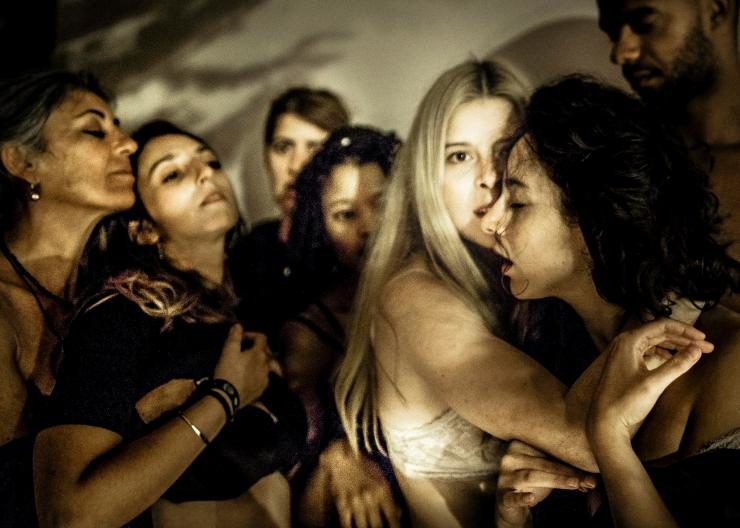
Rifar O Meu Coração with Mónica Calle, Sofia Vitória, Mónica Garnel, Cleo Tavares, Inês Vaz, Sofia Dinger and Luís Afonso. Photo by João Tuna.
For over two decades, Casa Conveniente was located in Cais do Sodré. In what was previously a bar, often with precarious resources, Calle staged her works, including Recordações De Uma Revolução (Memories From A Revolution) in 2011, based on Heiner Müller’s The Mission and which had in its cast two actors who Calle had met in the Vale de Judeus prison establishment. Beginning in 2009, Calle and professional actors, including Mónica Garnel, Rute Cardoso, and Ana Ribeiro, held weekly meetings in Vale dos Judeus, gathering a group with which they read, rehearsed, and presented plays. Some of these relationships continued on, by integrating the actors in Calle’s work. Many of these actors were residents of Bairro do Condado, which, along with the increasing tourism of Cais do Sodré, motivated Calle to move Casa Conveniente to a vacant building in the neighborhood.
In Rifar O Meu Coração (the 2016 version) actors take turns sharing fragments of their lives: a significant episode, a confession, a request, a report on that day’s mood. Each actor chooses one song to be their soundtrack, their motto—a complement to their account or final offer. Tears, laughter, music, and dance join audience and actors together. There have been several presentations of Rifar O Meu Coração, each following this simple structure but always with differences, either in the cast or in the accounts. In one of the presentations held in Bairro do Condado, contributions from the actors, such as René Vidal and Luís Afonso, mentioned their encounter with Calle and the consequences it had in their trajectories.
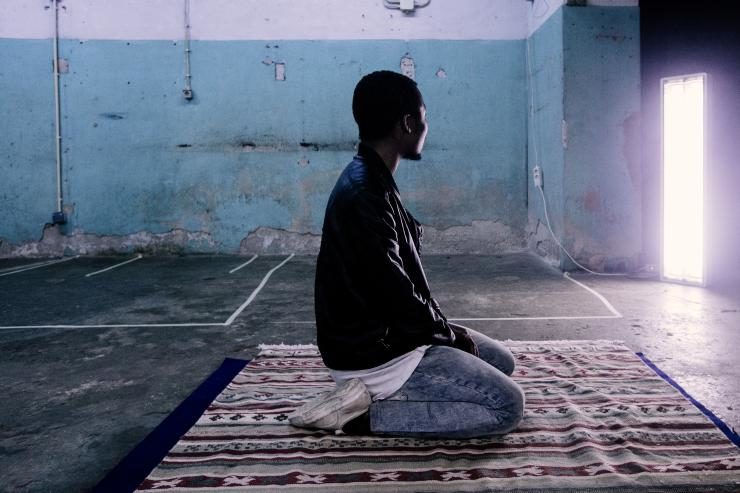
Medo A Caminho with Luís Mucauro. Photo by Alípio Padilha.
At the start of Medo A Caminho (2016), Rui Catalão reminds us that Michel Tournier, in one of his essays from The Mirror of Ideas, explores the hypothesis that in a very remote past, words were created for describing things not shareable as the material and visible world can be, things that become accessible only by the exercise of recounting, things like dreams. What follows, nevertheless, is the sole presence of Luís Leonardo Mucauro telling us a series of stories—not the matter of dreams, but the matter of someone’s life beyond dreams. Moving around an unfurnished space, Mucauro points at specific spots and creates diagrams of the imaginary spaces he names: the different houses where he lived, the waiting room and hospitals room where he and his sibling visited their father, the healer’s place where his brother was taken before he died, the spot where his girlfriend passed out after a fight Luís and his father had when his father prohibited their relationship, the spot on the ground where the police held him because he had no ID with him. The imagination alone, activated by the very accurate devices of choreography and dramaturgy, gave places and time corresponding images.
In Assembleia (2017), the audience is divided: two opposite groups of chairs, separated by a corridor. On one of the borders, Catalão presents the rules of the game: through the corridor, in the middle, the actors will expose their stories to the scrutiny of the audience, who are allowed to express their opinions—opinions that Catalão will encourage and respond to. Solange Ferreira and Pedro Henriques share how, through their lives, they have been mocked and bullied because of their appearance. Henriques had become so trapped by his fears—by his body and the projections he had of it—that he didn’t leave his apartment for years, just so he could avoid confrontation. Despite the theatrical apparatus, what is striking in Assembleia is the veracity of the stories and the movement made by these actors to overcome their own resistance and share their painful experiences.
A set of previously determined rules shapes E, Agora, Nós (2017), helping to structure the actors’ decisions in real time: “You have to look people eye to eye. It is forbidden to give ‘yes’ or ‘no’ answers. Your questions should not be discreet. Whoever answers should tell a story. You are not obliged to answer but you cannot prevent being asked questions that are even more indiscreet.” These rules regulate a “game of difficult questions” and function as a net: not exactly a safety net but a calibrated one—one that includes tension, dissent, and contrast. In a choreography that derives from a kind of bullying device called rodinha, the actors circle around one another and throw at each other not insults but questions: “When was the last time you humiliated someone?” “When was the last time you had to hold back your tears?” “What was the last important choice you had to make?” “Do you remember a time when you’ve felt guilty?” “Have you ever had a wish of yours disputed?” “When was the last time you felt like someone was unfair to you?” Sometimes the stories get to be told with a beginning, middle, and end; sometimes the stories that are being told are suspended or interrupted, and sometimes the stories are expanded by questions that are asked but not answered.
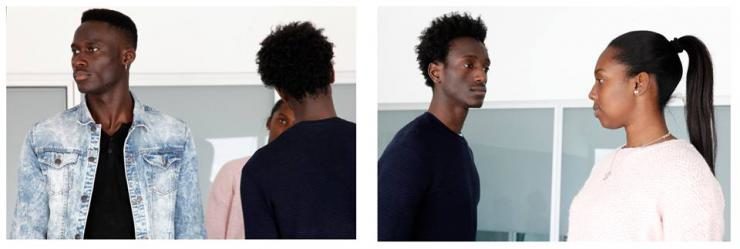
E, Agora, Nós with Adriano Diouf, Joãozinho da Costa, Jéssica Ribeiro and Vânia Lopes. Photo by Patrícia Almeida.
Both Catalão and Calle work with actors in the collective search for a way of doing things—in particular, a way of transmission, a way of telling stories, of moving “up and down the rungs of their experience as on a ladder,” as described by Walter Benjamin. In a sense, they rescue the space and ability to tell stories and, if Benjamin was right, “exchange experiences.” The circle of craftsmanship that weaves and spins around the storyteller finds its contemporary counterpart in the theatrical experience.
Each person is at the intersection of different “places of speech” and different “places of pain.” What can be shared? Perhaps the only possible shared experience is not lived experience but “exchanged experience” through stories. The stories remembered, the stories retold, have the potential to become, in a way, incorporated (“ingested,” as George Steiner would put it, once they are known by heart). Of course, the exchange is quite unbalanced—there are radically different consequences separating lived experience from its recounting. But otherwise, how can the “places of listening” be expanded?
Story by story, fragment by fragment, re-questioning one’s position(ing) in the world, grasping a fractal of life: it might be slow, but it is possible. Theatre can be part of it, by enabling the conditions of visibility for the manifold combinations of “places of speech” and “places of pain,” as well as enabling the conditions for the emergence and multiplication of “places of listening.”
This article was originally published on HowlRound on April 12, 2018. Read the original article. It has been republished with permission.
This post was written by the author in their personal capacity.The opinions expressed in this article are the author’s own and do not reflect the view of The Theatre Times, their staff or collaborators.
This post was written by Ana Dinger.
The views expressed here belong to the author and do not necessarily reflect our views and opinions.

